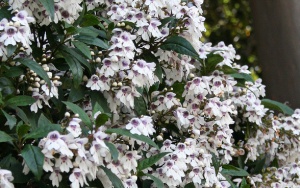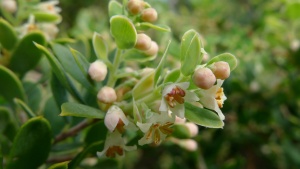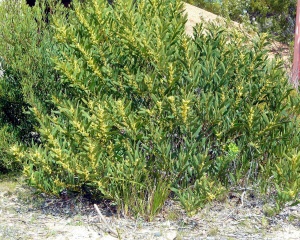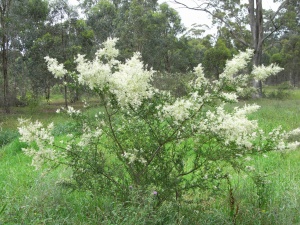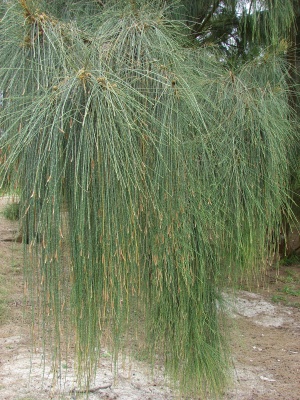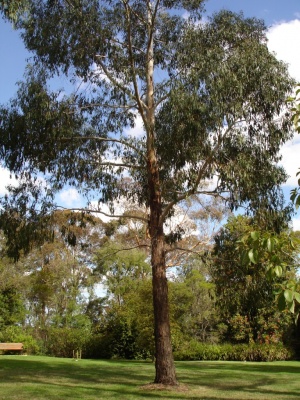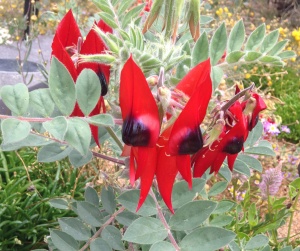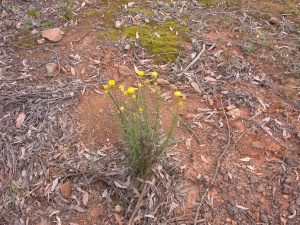Jen Sutfin
Victorian Christmas Bush
Evergreen shrub or small tree. Grows 1 – 6 m high.
Leaves
Bright yellow-green to dark green and paler underneath. They are 4 – 15 cm long and 1 – 3 cm wide, and generally have a toothed or curved edge. The leaves have a minty smell when crushed.
Flowers
Funnel-shaped and white, or pink to pale mauve, with purple and orange spots inside. They are about 2 cm long and grow in clusters at the end of branches. They are slightly scented.
Tree Lomatia
Upright rounded shrub or small tree that grows 8 - 11 m high although it can be much smaller if it is found in exposed areas. Trunk and branches are grey to dark brown.
Leaves
Lanceolate (lance-shaped) to elliptic (rounded) in shape, measuring 6 – 12 cm in length and 1 - 3.5cm in width. Leaves are leathery to the touch with upper surface of the leaf being a dull green while the underside is pale yellow-green. The margins of the leaf are deeply or shallowly toothed, occasionally entire or sometimes deeply lobed.
Flowers
Flowers may be held in clusters up to 12 cm long. Blooms are white to cream, fragrant and usually abundant when flowering. Flowers are very hairy and spidery in appearance.
Tree Broom Heath
Bushy shrub or small tree, up to 4m in height.
They can live for over 100 years.
Leaves
Oblong-shaped, usually 1 - 2.5 cm long and 0.5 cm wide.
Flowers
Solitary, white and have circular petals, 8 Usually in groups of 4 - 16 at end of branches. Creamy white in colour.across. Usually appear between December and April.
Sydney Golden Wattle
Large shrub up to 8 m tall.
Leaves
Light green phyllodes (flattened leaf stalks) 14 - 2 0cm long and 2 - 3 cm wide. Several longitudinal veins.
Flowers
Bright yellow flowers arranged forming elongate clusters.
Sweet Scented Wattle
It was first described by renowned botanist J.E. Smith, the founder of London’s Linneaen Society.
Evergreen shrub with smooth, purplish brown or light green bark. Up to 0.3 – 3 m high.
Leaves
Narrow, straight or very slightly elliptic, and blue-green. Each leaf is about 5 – 15 cm long and 2 – 10 mm wide, with a prominent vein down the centre. Its surface is hairless and covered with a fine white powder. It grows at right angles to the stem.
Flowers
Pale yellow to white and ball-shaped. Each flower is 4 – 7 mm in diameter and is found in clusters of 5 – 10 flowers aligned along an axis of 1 – 3 cm long. They are sweet smelling and enclosed in overlapping bracts (modified leaves) before opening.
Sweet Bursaria
Also know as Blackthorn.
A woody shrub to small tree, usually with thorny branches. Grows up to 5 – 10 m high.
Leaves
Glabrous, dark green, 20 – 44 mm long and 5 – 9 –mm wide.
Flowers
White, 6 – 10 mm wide, fragrant.
Swamp She-Oak
Evergreen tree, greyish-brown bark has oak-like appearance, branchlets spreading or drooping. Can be found solo or in dense stands.
Usually 8 – 15 m high. Can reach a maximum of 20 m high (rarely) and only reaches 2 m high on clifftops. The trunk can be up to 35 cm in diameter. This tree is also found in prostrate form (lying flat on the ground), reaching 30 cm high and 2 m wide.
Leaves
Segmented branchlets with very small teeth-like leaves (0.6 - 0.9 mm long), 12 – 17 leaves arise at the nodes of segments. New growth is strongly recurved (bent or curved backwards or downwards) and become erect as they mature.
Flowers
This species is dioecious (male and female reproductive structures develop on different individuals). Male inflorescences (arrangement of flowers) are spikes, growing 1.2 – long with 7 - 10 whorls per cm (ring of floral parts borne at the same level) and a 0.8 mm long anther (pollen-bearing part of the stamen).
Swamp Gum
Lowland Leadbeater’s Possum and Helmeted Honeyeater feed on the flowers of this species, which flowers at a different time from the Mountain Swamp Gum. This overlap of flowering time provides food across an extended period for these creatures.
Small to medium tree, 20 m tall. Bark is variable, dark and rough at the butt; upper trunk and branches peel in ribbons.
Leaves
Juvenile leaves are short-stalked, almost circular. Adult leaves are thick, glossy, dark green, ovate shaped, usually has a wavy edge.
Flowers
White cluster of 3 - 10 (often 7).
Sturt’s Desert Pea
Although named after the early explorer, Charles Sturt, this legume was first collected by William Dampier on an island in the Dampier Archipelago in 1699.
Low spreading ground cover up to 3 m wide and 30 cm high.
Leaves
Dull green leaves are made up of 7 pairs of oval-shaped leaflets. Stems leaves and pods are covered in short soft hairs.
Flowers
Red flowers are arranged in upright stalks in groups of 3 or more. Each flower is up to 9 cm from the top of the standard to the base of the keel. The standard is the large petal with the black dome at its base. In some plants the dome may be red and albino varieties with completely white flowers have been found in the Pilbara.
Sticky Everlasting
Was previously named Bracteantha viscosa, and before that Helichrysum viscosum.
Small stiff herb with multiple branches and hair covered stems. Grows up to 20 - 80 cm high.
Leaves
Stems with fine hairs or prickles. 30 - 100 mm long and 2 - 10 mm wide linear leaves with bright green elliptic (oval like shape) that have a sticky and rough surface.
Flowers
Bright yellow flower heads, 20-30mm wide. Displays colours of gold, orange, bronze or vibrant yellow. These appear in September to December but may occur later. Large single flower surrounded by many bracts (petals).

